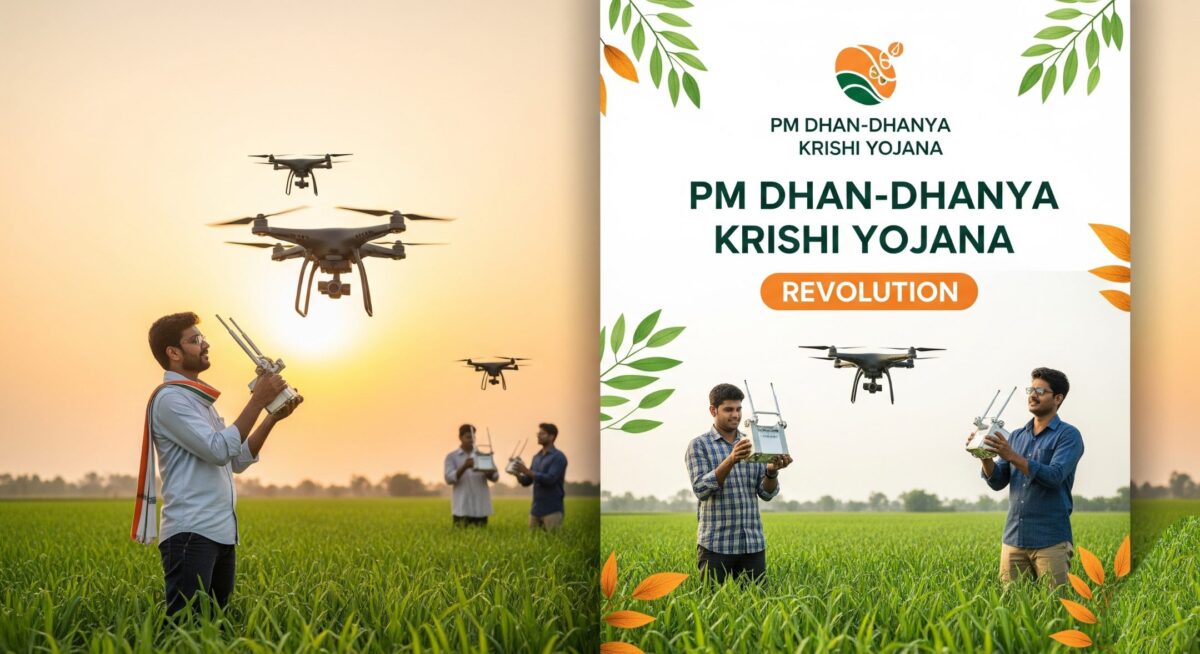PM Dhan-Dhanya Krishi Yojana:
PM Dhan-Dhanya Krishi Yojana: India’s agricultural sector, the backbone of its economy, is set for a revolutionary boost with the PM Dhan-Dhanya Krishi Yojana (PMDDKY). Announced in the Union Budget 2025-26 by Finance Minister Nirmala Sitharaman and approved by the Union Cabinet, this six-year scheme (2025-26 to 2030-31) targets 100 low-productivity districts to uplift 1.7 crore farmers through technology, credit access, and sustainable practices .
Why Was PMDDKY Scheme Launched?
India faces stark disparities in farm productivity between states and districts. Key challenges include:
- Low crop yields due to outdated farming techniques.
- Limited irrigation access and inadequate storage infrastructure, causing post-harvest losses.
- Restricted credit flow to small farmers.
Inspired by NITI Aayog’s Aspirational Districts Programme, PMDDKY addresses these gaps by converging 36 existing schemes across 11 departments into a unified mission .
Key Objectives: PM Dhan-Dhanya Krishi Yojana: Approach
- Boost Productivity: Promote climate-resilient seeds, precision farming, and AI-driven tools .
- Diversify Crops: Reduce reliance on staples by incentivizing pulses, oilseeds, fruits, and vegetables .
- Improve Water Management: Expand micro-irrigation (drip/sprinkler) and watershed projects .
- Enhance Credit Access: Via Kisan Credit Cards (KCC) and the new ‘Grameen Credit Score’ for rural borrowers .
- Cut Post-Harvest Losses: Build panchayat/block-level storage and cold chains .
Implementation Strategy: How It Works
District Selection
Districts are chosen based on:
- Low productivity and moderate cropping intensity.
- Below-average credit disbursement.
- Each state/UT gets at least 1 district .
Governance Structure
- District Dhan-Dhaanya Samiti: Local committees with progressive farmers to create tailored agriculture plans.
- 117 Performance Indicators: Track monthly via dashboards (e.g., yield improvement, credit flow) .
- Convergence Model: Integrates central schemes (e.g., PM-KISAN, PMFBY) and state initiatives .
Funding
- Annual Outlay: ₹24,000 crore.
- Total Agricultural Budget (2025-26): ₹1.37 lakh crore (4% YoY increase) .
Eligibility: Who Benefits?
Priority groups include:
- Small/marginal farmers, women farmers, and landless families.
- Youth engaged in agriculture (18–45 years).
- Farmers in the 100 targeted districts .
Required Documents: Land records, Aadhaar card, bank details, and income certificate .
Expected Impact: By the Numbers
- 1.7 crore farmers to gain higher incomes and climate resilience .
- 20-30% productivity boost in target districts through modern techniques .
- Reduced migration by creating rural enterprises and agri-jobs .
Economic Ripple Effect: Sectors like agri-inputs (fertilizers, seeds), farm equipment (tractors), and rural FMCG to see growth .
Challenges & Solutions
| Challenge | Solution |
|---|---|
| Low fund utilization | Real-time tracking; quarterly reviews |
| Farmer awareness gaps | Regional campaigns via SHGs/cooperatives |
| Climate vulnerabilities | Promote drought-resistant crops |
| Bureaucratic delays | PPPs for cold chains/logistics |
Success Stories in the Making
- Pulses Self-Reliance Mission: A 6-year sub-scheme focusing on tur, urad, and masoor pulses. Agencies like NAFED will procure harvests at guaranteed prices .
- Maharashtra, UP, and MP: Top recipient states (allocations: ₹3,500 cr, ₹2,900 cr, ₹2,600 cr) driving localized crop diversification .
FAQs
1. How to apply for PMDDKY?
Contact local agriculture offices with required documents for verification .
2. What makes PMDDKY unique?
Its district-specific approach and convergence model avoid policy fragmentation .
3. Does PMDDKY support organic farming?
Yes! It promotes bio-fertilizers and soil health management .
Conclusion: A Game-Changer for Rural India
The PM Dhan-Dhanya Krishi Yojana marks a shift from blanket subsidies to targeted, outcome-driven interventions. By empowering farmers with technology, credit, and infrastructure, it aims to bridge India’s agricultural divide and build Atmanirbhar Krishi (self-reliant farming). Success hinges on efficient fund use, tech adoption, and participatory governance—but if executed well, it could blueprint agricultural transformation globally .
Key Takeaway: PMDDKY isn’t just a scheme; it’s a 100-district mission to make small farmers climate-proof and commerce-ready.
Read More:
- DHFWS West Bengal CHO Recruitment 2025: 483 Community Health Officer Vacancies
- Jharkhand Home Guard Vacancy 2025: Apply for 463 Posts Online
- IBPS RRB Recruitment 2025: 13,217 Vacancies for Banking Professionals | Complete Guide
- ECIL ITI Trade Apprentice Recruitment 2025: Complete Guide for 412 Vacancies
- IOCL Apprentice Recruitment 2025: Complete Guide to Apply for 500+ Vacancies
